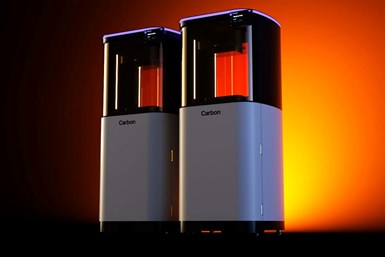Carbon’s M3, M3 Max Designed for Faster, Larger, Smoother DLS Printing
The new generation of 3D printers is said to bring faster printing, larger build volume and new capabilities to the Carbon Digital Light Synthesis (DLS) platform.

The M3 and M3 Max DLS printing is said to create substantially lower forces on the part and introduces closed-loop control of force and temperature to reduce failure modes and simplify the print experience. Photo Credit: Carbon
Carbon’s M3 and M3 Max DLS printers are said to provide an advanced end-to-end, idea-to-production platform when combined with Carbon’s Design Engine and DLS materials. The M3 is designed for faster printing, simpler print experience, expanded design space and more consistent surface finish. The M3 Max offers the same benefits as well as a 4K light engine to enable double the build area with the same pixel size and density.
The company says the M series works with a wide range of high-performance materials tailored for applications across industries such as automotive, life sciences, dental, consumer products and industrial. The printers are said to enable design teams to create high-quality prototypes with end-use performance quicker and more efficiently. And, once product development is complete, this platform is said to enable companies to move to production quickly and efficiently anywhere in the world.
The DLS printing is said to create substantially lower forces on the part and introduces closed-loop control of force and temperature to reduce failure modes and simplify the print experience. The printers also offer a broader design space, making parts that prior generations could not and unlocking more geometries (especially for elastomeric parts) or parts with features most sensitive to high forces.
Both printers enable faster printing thanks to better heat management, delivering more throughput per square foot in thermally limited scenarios, the company says. The printers are also said to produce smoother parts than prior generations. Parts are also more consistent parts as the printers are said to reduce the variation in parts across a single build by up to 50% — translating to less variation in general accuracy and more production repeatability in engineering resins.
According to the company, installion is fast and easy with the M3 installed in hours, with the ability to relocate the printer within facilities as customers see fit. The M3 Max features a larger build area, offering double the build area with the same pixel size and density as the M3 printer, making it well suited for larger parts or producing many smaller parts with similar quality.
Related Content
-
3D Printed Lattices Replace Foam for Customized Helmet Padding: The Cool Parts Show #62
“Digital materials” resulting from engineered flexible polymer structures made through additive manufacturing are tunable to the application and can be tailored to the head of the wearer.
-
Copper, New Metal Printing Processes, Upgrades Based on Software and More from Formnext 2023: AM Radio #46
Formnext 2023 showed that additive manufacturing may be maturing, but it is certainly not stagnant. In this episode, we dive into observations around technology enhancements, new processes and materials, robots, sustainability and more trends from the show.
-
3D Printed Spine Implants Made From PEEK Now in Production
Medical device manufacturer Curiteva is producing two families of spinal implants using a proprietary process for 3D printing porous polyether ether ketone (PEEK).













